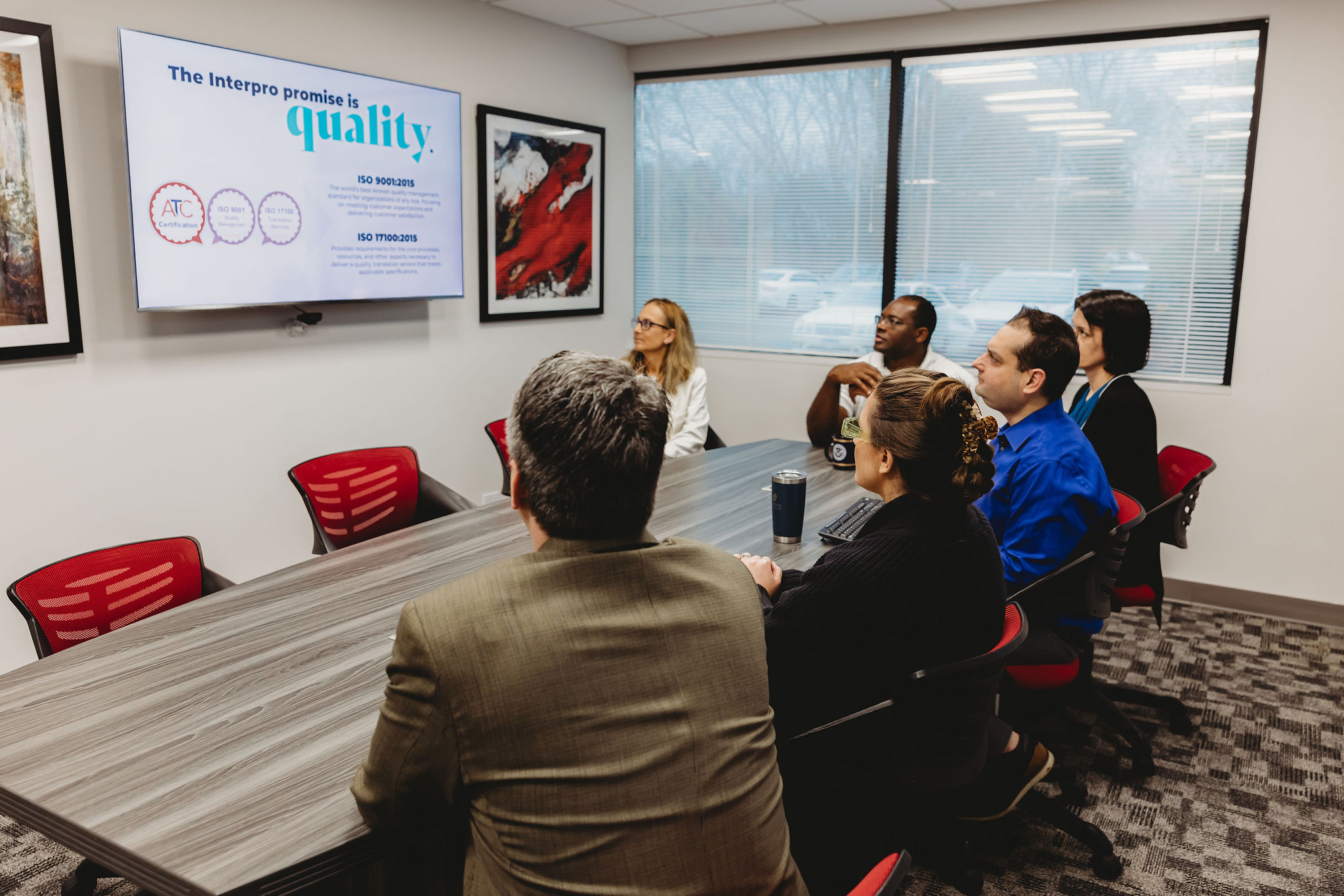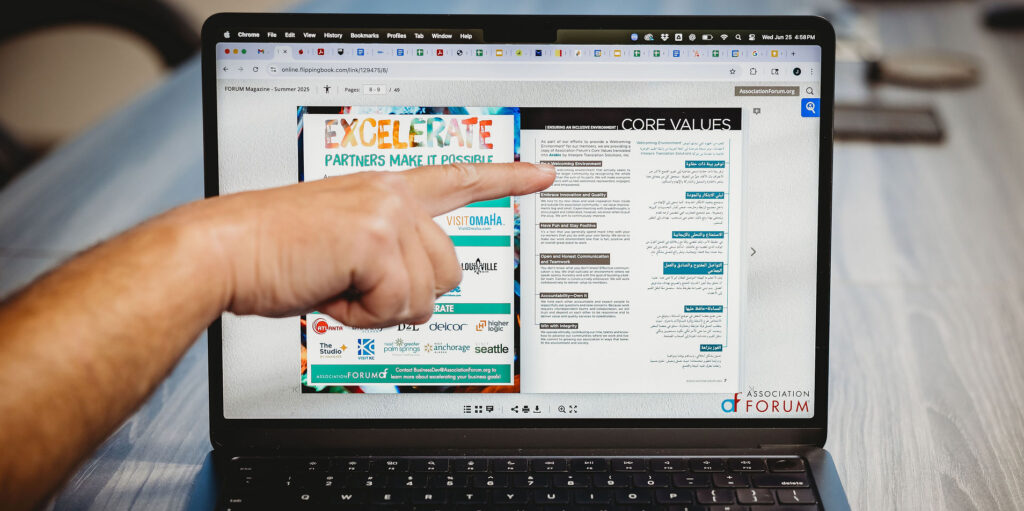
A translation needs assessment helps businesses optimize localization workflows, improve quality, and ensure ROI from translation investments. This guide explains when and why to conduct one, what it includes, and how Interpro supports the process.
What Is a Translation Needs Assessment?
A translation needs assessment is a structured evaluation of an organization’s current translation and localization processes. Its purpose is to identify gaps, inefficiencies, and opportunities for improvement. For companies translating content across multiple languages, a needs assessment ensures that resources are being used wisely and that the final output supports business goals.
This assessment is not a one-size-fits-all checklist. Instead, it’s a tailored review that takes into account your industry, target markets, content types, and translation history. It lays the foundation for a scalable localization strategy by aligning teams, vendors, technologies, and processes.
In other words, a translation needs assessment helps you go from reactive translation to proactive localization.
Signs You Need a Translation Needs Assessment
How do you know it’s time to assess your translation strategy? Here are a few red flags:
Inconsistent workflows and quality issues
- Are some documents translated internally while others are outsourced to vendors?
- Do different departments follow their own localization processes or apply varying quality standards?
- Do you work with different translation teams and are unsure of the translation quality?
- Are you unsure of how to improve your current translation workflows to help you scale translation efforts?
When workflows are inconsistent across teams, it can lead to a range of issues such as missed deadlines, confusing translations, and increased scope costs. These discrepancies can also dilute your brand voice, confuse end users, and create inefficiencies that are difficult to track or resolve (and make it impossible to get ahead).
How Interpro Helps:
Our experts can review your translation process, technology, and linguists and provide actionable advice on how to improve your translation workflows.
The skilled localization experts on the Interpro team can help assist you with any of the questions above and help you establish a unified, transparent localization strategy across departments to align internal teams and external partners.
Difficulty evaluating ROI or translation effectiveness
If you can’t clearly measure whether translation is driving meaningful outcomes (or how much it’s truly costing your organization), you may be missing critical opportunities to optimize both performance and budget. Without visibility into the impact of translation efforts, it becomes difficult to justify investments, prioritize resources, or identify areas for improvement.
A comprehensive needs assessment helps bridge this gap by establishing clear goals and identifying key performance indicators (KPIs) that align with your business objectives. These KPIs might include metrics like time-to-market, customer satisfaction scores, engagement rates in localized content, or cost per word across vendors. By tracking these indicators, you can evaluate the return on investment (ROI) of your translation efforts, uncover inefficiencies, and make data-driven decisions that enhance both quality and cost-effectiveness.
Ultimately, a data-informed approach empowers you to treat translation not just as a cost center, but as a strategic asset that supports global growth and customer experience.
How Interpro Helps:
When reviewing your process, people, and technology, we can provide suggested metrics to track and process improvement opportunities to reduce inefficiencies and maintain consistent translation quality.
Underutilized Translation Technology
Many organizations invest in powerful localization tools like Trados, Phrase, or develop comprehensive translation memories (TMs), terminology glossaries, and style guides.
But these resources are often underutilized or inconsistently applied across teams and projects. This can lead to duplicated efforts, inconsistent terminology, and missed opportunities for cost savings and quality improvements.
Similarly, AI translation workflows that combine the speed of machine translation with human editing can be highly efficient, but only if editors are trained, quality expectations are clear, and the right content types are selected for automation.
By identifying gaps in tool usage and workflow alignment, organizations can unlock the full potential of their localization tech stack, improving consistency, reducing turnaround times, and maximizing return on investment.
How Interpro Helps:
A needs assessment can uncover where these tools are being underused, misused, or where they could deliver greater value. For example, Trados and Phrase offer robust TM and terminology management features, but if teams aren’t aligned on usage protocols or if integrations aren’t optimized, the benefits are diminished.
Key Components of a Translation Needs Assessment
Vendor performance review
A Vendor Performance Review is a critical step in ensuring your language service providers (LSPs) are aligned with your business goals and translation quality expectations. This process involves a structured evaluation of your current vendors across several key dimensions:
- Quality: Are the translations accurate, culturally appropriate, and aligned with your brand voice? Are they consistently using your approved terminology, tone, and style guides?
- Turnaround Time: Are deadlines being met reliably? Are urgent requests handled efficiently without compromising quality?
- Communication: Is the vendor responsive, proactive, and transparent in their communication? Do they provide clear updates, flag potential issues early, and collaborate effectively with your internal teams?
- Tool Usage: Are they effectively leveraging your translation memory (TM), glossaries, and preferred platforms like Trados or Phrase? Are they following your MTPE workflows where applicable?
- Consistency: Are they delivering consistent results across different content types, languages, and projects? Or do you notice variability depending on the translator or project manager?
- Scalability and Flexibility: Can the vendor scale with your needs as your content volume grows or as you expand into new markets? Are they flexible enough to adapt to evolving requirements?
A thorough review helps you identify high-performing vendors, flag underperformers, and uncover opportunities for process improvements or cost savings. It also opens the door for more strategic partnerships, where vendors become true collaborators in your global content strategy and not just service providers.
How Interpro Helps:
Interpro has experience building localization workflows for nearly every major platform and professional linguistic teams in 128+ languages. We can help you interview, score, and select the best translation agency for your goals, or provide surveys and quality scoring analyses to review current vendors.
Workflow and process analysis
Taking a detailed look at your translation process from the moment content is created to its final review and approval can reveal hidden inefficiencies that drain both time and resources.
This kind of analysis often uncovers redundant steps, unclear responsibilities, or manual processes that could be automated. For instance, content might be passed back and forth between departments without a clear owner, or reviewers may be working from outdated versions due to a lack of centralized tools.
Another equally important process to examine is how translation tasks are handed off between teams:
- Are source files being prepared in a way that’s compatible with your translation tools?
- Are translators receiving the context they need to work efficiently and accurately?
- Are reviewers and approvers looped in at the right stages, or are they brought in too late and causing delays or even rework?
By mapping out these handoffs and identifying where breakdowns occur, you can streamline collaboration, reduce turnaround times, and ensure that everyone involved in the localization process is working from the same playbook. This not only improves operational efficiency but also enhances the overall quality and consistency of your multilingual content.
How Interpro Helps:
We partner with you to find gaps in your translation workflows and train your team on how to close those gaps. From identifying bottlenecks, to writing localization-friendly source files, and how to QA final translations in a different language, we make sure your team is prepared on handling the localization process.
Technology and tool audit
This step involves a comprehensive evaluation of:
- your current localization technology stack
- machine translation engines
- AI translation tools or translation as a feature (TaaF) tools
- computer-assisted translation (CAT) tools
- translation memories (TMs)
- glossaries
- content management system (CMS) integrations
- review and quality assurance processes
The goal is to understand how effectively these tools are supporting your workflows and where they may be introducing unnecessary complexity or inefficiencies.
For example:
- Are your CAT tools (like Trados or Phrase) fully integrated with your CMS, or are teams manually exporting and importing content?
- Are your TMs and glossaries centralized and consistently updated, or are different teams using outdated or conflicting versions?
- Are your review platforms intuitive and collaborative, or do they create bottlenecks in the feedback loop?
How Interpro Helps:
We provide analysis that helps identify:
- Redundant or underused tools that could be consolidated or retired.
- Gaps in automation where manual processes could be streamlined.
- Integration issues that slow down content flow between systems.
- User adoption challenges, such as lack of training or unclear processes.
By pinpointing which tools are truly adding value and which are causing friction, you can make informed decisions about optimizing your tech stack to improve efficiency, consistency, and scalability across your localization program.
Stakeholder interviews and documentation review
Gathering input from key stakeholders is essential for understanding the real-world challenges and inefficiencies within your localization process. To get a complete picture of your needs, collaborate with:
- technical writers
- content creators
- reviewers
- translators
- project managers
- localization engineers
These individuals are closest to the day-to-day operations and can provide valuable insights into what’s working, what’s not, and where improvements are needed.
For example:
- Marketers or content creators might highlight issues with unclear source text or tight timelines, while translators may point out inconsistencies in terminology or lack of context.
- Localization engineers and project managers can shed light on bottlenecks, communication gaps, or tool limitations.
- A DTP specialist can point out how to format source files for easier translation.
In parallel, reviewing existing documentation (such as brand guidelines, translation style guides, tone-of-voice documents, and workflow SOPs) helps assess how well your current processes support consistency, quality, and scalability. Are these resources up to date? Are they being followed consistently across teams and languages? Are they accessible and easy to use?
This dual approach of combining stakeholder feedback with documentation review provides a holistic view of your localization ecosystem. It helps identify both systemic issues and quick wins, ensuring that your strategy is grounded in real-world needs and aligned with your brand’s standards.
Interpro provides consultative advice to clients over many different growth strategies through language, such as translation needs assessments.
How Interpro Helps:
Interpro can help you conduct stakeholder interviews and review existing workflow documentation. Let us know how our team can support you.
Benefits of Conducting the Assessment
The real value of a translation needs assessment lies in what it unlocks for your business.
Identifying hidden inefficiencies and cost savings
A comprehensive audit of your localization operations can reveal hidden inefficiencies that may be costing your organization time and money. These often include duplicated efforts, such as multiple teams translating the same content independently, or maintaining separate translation memories that aren’t shared across departments. It can also uncover outdated tools that no longer integrate well with your current systems, or lack the automation features needed to support modern workflows.
Additionally, many teams still rely on manual processes (like copy-pasting content between systems, or tracking terminology in spreadsheets) that could be streamlined or fully automated using integrated platforms and workflow tools. These inefficiencies not only slow down delivery but also increase the risk of errors and inconsistencies.
Aligning localization efforts with business objectives
With a clear understanding of your translation landscape including tools, workflows, stakeholder needs, and vendor performance, you can better align your localization strategy with your broader business objectives. This alignment ensures that translation is not just a support function, but a strategic enabler of growth and efficiency.
Examples of localization strategy for business growth:
- Entering new markets: If your company is expanding into Latin America or Southeast Asia, a well-aligned translation strategy ensures that product documentation, marketing materials, and customer support content are localized accurately and are culturally adapted. This helps build trust with new audiences and accelerates market entry.
- Improving customer experience: For global customers, accessing content in their native language (whether it’s onboarding guides, FAQs, or in-app messages) can significantly improve satisfaction and reduce support tickets. A consistent translation process ensures that messaging is clear, helpful, and aligned with your brand voice across all touchpoints.
- Supporting multilingual staff: In organizations with a diverse workforce, translating internal communications, training materials, and HR policies helps ensure inclusivity, compliance, and employee engagement. A streamlined translation process ensures that all employees receive timely and accurate information, regardless of language.
By aligning your translation efforts with these kinds of strategic goals, you can demonstrate clear ROI, improve operational efficiency, and deliver a more cohesive global experience for both customers and employees.
Setting measurable KPIs and quality standards
A needs assessment helps transform vague perceptions of translation performance into clear, measurable benchmarks that can be tracked and acted upon.
Rather than relying on anecdotal feedback or gut feelings, you gain concrete data points that reflect how well your localization efforts are functioning. We recommend tracking these benchmarks:
- turnaround times
- cost efficiency
- review accuracy
- user satisfaction
These KPIs become essential tools for guiding strategic decisions. They allow you to monitor progress over time, identify areas for improvement, and demonstrate the tangible value of your translation program to stakeholders. With this clarity, you can shift from reactive problem-solving to proactive optimization, ensuring that your localization efforts are not only efficient but also aligned with broader business goals.
Common Translation Needs Assessment FAQs
What is a translation needs assessment?
It’s a systematic evaluation of your translation and localization practices, aimed at improving efficiency, consistency, and ROI.
How do we know if our current process is working?
If you’re experiencing delays, quality issues, or confusion about how translation decisions are made, it’s time for a review.
What should be included in the assessment?
A vendor review, workflow analysis, tech audit, and stakeholder feedback are essential. You should also assess terminology management, project scoping, and quality control processes.
How long does the assessment take?
This depends on your organization’s size and complexity, but most assessments can be completed in a few weeks with the right partner.
Will the results justify the investment?
Yes. Clients often realize cost savings, faster delivery times, and higher translation quality after implementing recommendations.
Interpro’s Approach to Conduct A Translation Needs Assessment
At Interpro, we take a consultative approach to translation needs assessments. Here’s how we support our clients:
Tailored assessments by industry
Whether you operate in healthcare, education, manufacturing, or the nonprofit sector, Interpro Translation Solutions customizes every assessment to reflect the unique demands of your industry.
We understand that each field comes with its own specialized terminology, compliance standards, and audience expectations. For example:
- We focus on localization and cultural relevance to support diverse audiences in many industries.
- For manufacturing clients like Klein Tools, we emphasize precision and consistency in technical documentation, safety manuals, and product labeling.
- And in the nonprofit sector, we tailor messaging to resonate with communities while maintaining the integrity of your mission.
By aligning our assessments with your industry’s language, regulatory landscape, and user needs, we help you deliver high-quality, impactful content across every market you serve.
Get an end-to-end evaluation of systems, vendors, and workflows.
Work with our team to go far beyond surface-level analysis. We take a deep dive into how translation fits into your broader content ecosystem and provide consultative advice. We examine not just the words on the page, but how our team can support your brand, user experience, and global communication goals.
Our assessments are comprehensive, evaluating every stage of the localization workflow, from initial file preparation and content formatting to translator handoffs, in-context reviews, and final quality assurance. We look at how content flows between systems, how teams collaborate, and where friction points may be slowing you down or compromising quality. By understanding the full lifecycle of your content, we help you build a translation process that’s not only accurate and efficient, but also fully aligned with your strategic objectives.
Actionable roadmap for scalable localization success
After conducting a thorough assessment, we provide a prioritized, actionable roadmap designed to elevate your localization program. This plan goes beyond general recommendations; it’s tailored to your specific goals, challenges, and infrastructure. We outline which improvements will have the greatest impact and in what order they should be tackled for maximum efficiency.
Our action plan may include tool recommendations such as:
- Adopting or optimizing translation technology like CAT tools, translation management systems, glossaries, or style guides.
- Implementing internal client reviews (ICRs) and quality scoring.
- Developing processes that streamline workflows to eliminate bottlenecks, reduce manual effort, and enhance collaboration between teams.
- Formulating content development approaches for source language files.
- Monitoring vendor performance with strategic evaluation for partner consolidation or diversification to ensure quality and scalability.
- Defining key performance indicators (KPIs) like turnaround time, cost-per-word, or quality scores so you can track improvements and demonstrate ROI over time.
We equip you with a clear, strategic path forward: one that transforms insights into measurable results.
For example, when SEIU 775 Benefits Group needed to streamline multilingual caregiver training, Interpro developed an integrated localization strategy and training bootcamp for their team that now supports over 9,000 ESL caregivers with accurate, culturally-relevant content. Our partnership included not only translation, but glossary development, DTP, and continuous process improvement.
Start Your Translation Needs Assessment
Meet with our team to discover our service solutions and how we can help support you in building a translation workflow that can scale with your business’ operations.
If you’re managing translation across departments or languages and wondering how to improve, a translation needs assessment is the right place to start. It gives you the data, clarity, and direction needed to build a smart, scalable localization strategy.
Whether you’re refining your current approach or building one from scratch, we’re here to help you achieve better results across every language and market.
Category: Translation
Tags: localization strategy, translation needs assessment
Service: Consulting, Translation Services
Don't forget to share this post!
Stay Updated with Interpro
Subscribe to our newsletter for the latest updates and insights in translation and localization.






